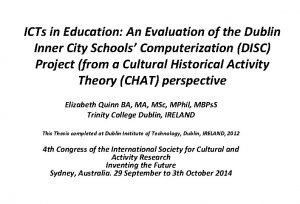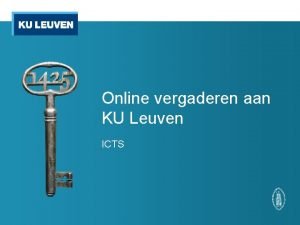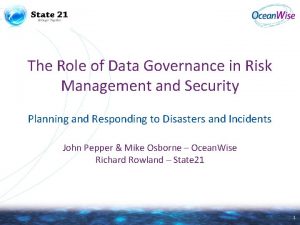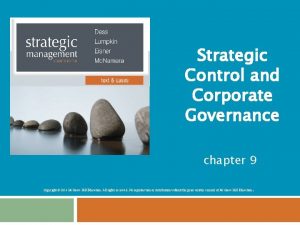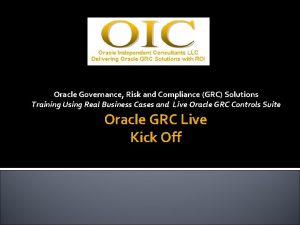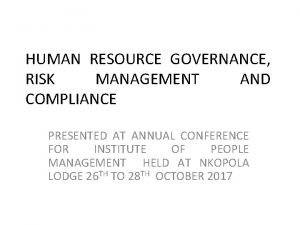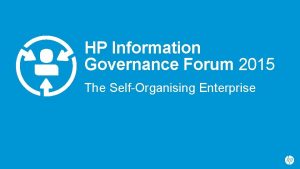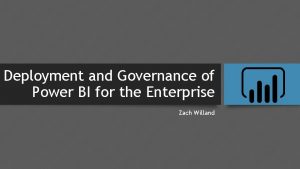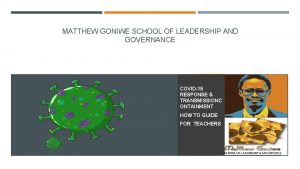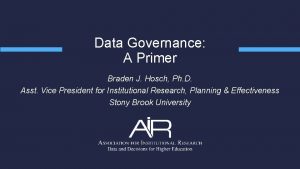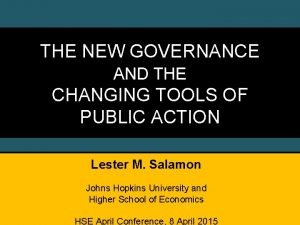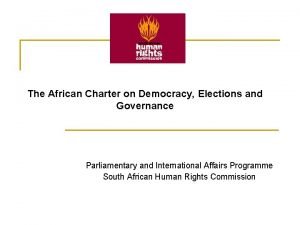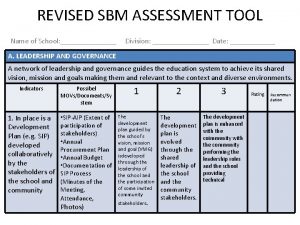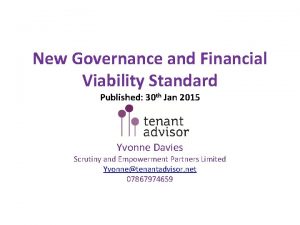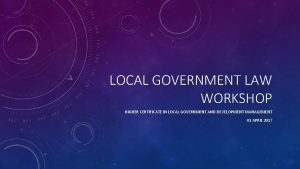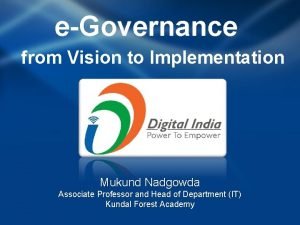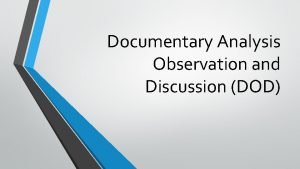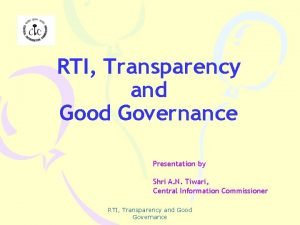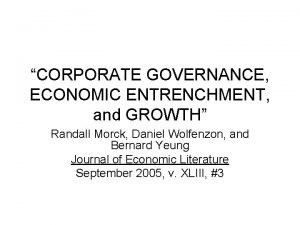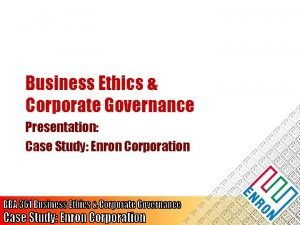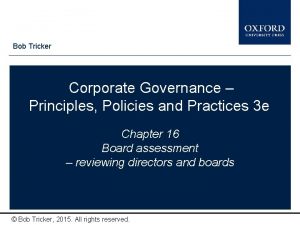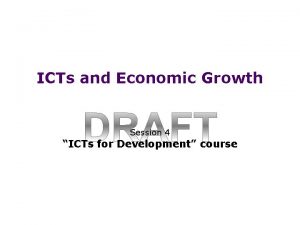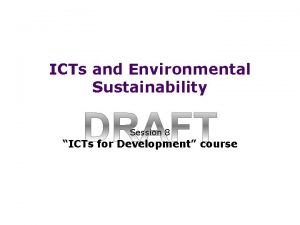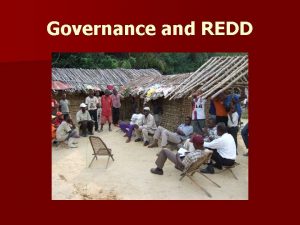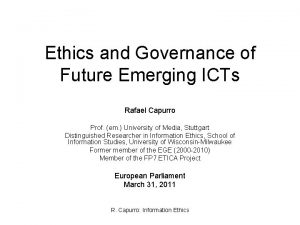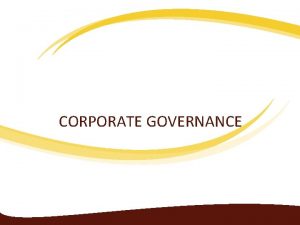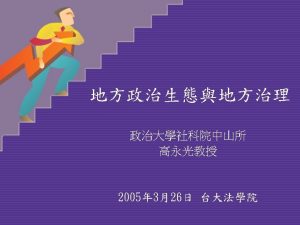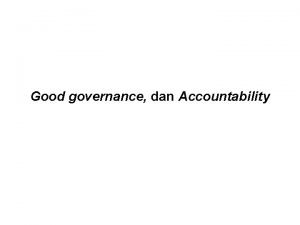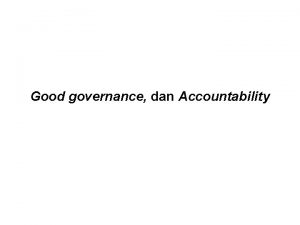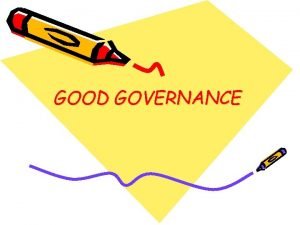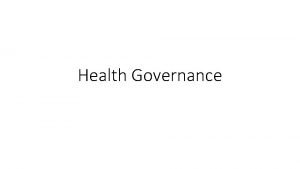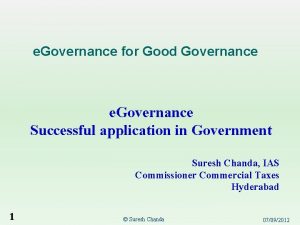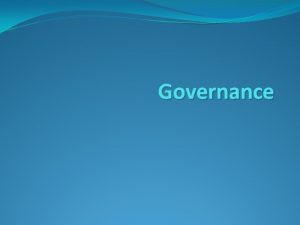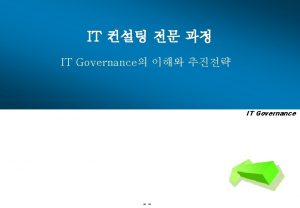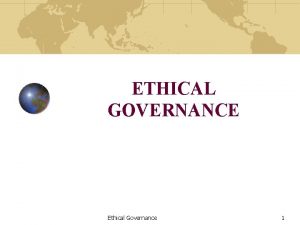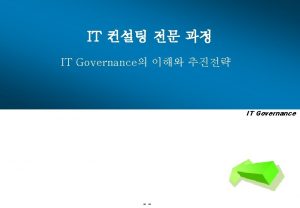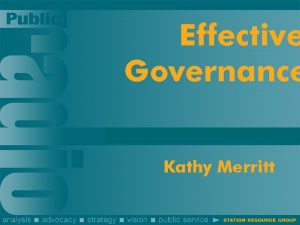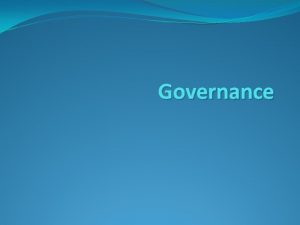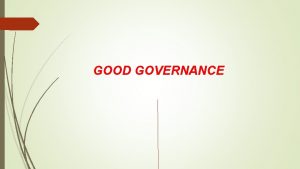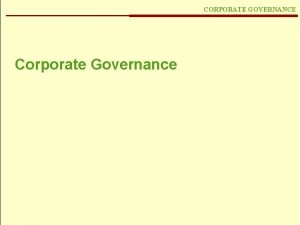Workshop on ICTs and Governance in Europe and


































- Slides: 34

Workshop on ICTs and Governance in Europe and China Key performance indicators to shape Smart Sustainable Cities Bilel Jamoussi Chief ITU-T Study Groups Department 25 November 2016

15 years of ICT Growth: What have been achieved ? 100 Global ICT developments, 2001 -2016 99. 7 Mobile celular telephone subscriptions 90 Per 100 inhabitants 80 Individuals using the internet 70 60 49. 4 47. 1 50 40 Fixed telephone subscriptions Active mobile broadband subscriptions 30 13. 7 20 10 11. 9 0 2001 2002 2003 2004 2005 2006 2007 2008 2009 2010 2011 2012 2013 2014 2015 2016* Note: * Estimate Source: ITU World Telecommunication /ICT Indicators database Fixed broadband subscriptions

Technology is changing… Our cities are changing… London, 1980 London, 2016

Some facts about cities By 2050, it is expected that 66% of the population in the world will be living in urban areas Cities contribute to up to 70% of the total greenhouse gas emissions. Half the world’s population will be online in 2018 and by the end 2018, 51. 1% of the population (3. 82 billion people) will be using the internet Of today’s 28 mega-cities, 16 are located in Asia, 4 in Latin America, 3 each in Africa and Europe, and 2 in Northern America. By 2030, the world is projected to have 41 mega -cities with more than 10 million inhabitants Tokyo Population 2030: 37 million Delhi Population 2030: 36 million Mexico City Population 2025: 24. 6 million Source: United Nations, Department of Economic and Social Affairs Statistics, Frost & Sullivan and other regional and country level statistics bureau

Cities challenges vs citizens’ interests Waste & Water Management Tourism & cultural engagement i. e. Sao Paulo, New Delhi, Panama Traffic & mobility Management) i. e. Beijing, Barcelona, Cairo Electricity Supply i. e. Caracas, Germany i. e. Paris, Buenos Aires, Florence Cities interests Business & commerce i. e. Berlin, New York, Tokyo. Safety i. e México City, Rio de Janeiro Sources: (1) Mc. Kinsey Global Institute - Big Data Report, May 2011. (2) 2012 E, Strategy Analytics , Global Social Network Market Forecast, Oct 2011. (3) United Nations, April 2010, (4) Youtube 2011

How do we shape Smarter and More Sustainable cities

Pathway for Smart Sustainable Cities 6. Ensure accountability and responsibility 5. Measure your city’s progress 4. Build your SSC Guide for City Leaders Smart Sustainability City cycle 1. Set the vision for your SSC venture 2. Identify your SSC targets 3. Achieve political cohesion

1. Set the vision for your SSC venture 2. Identify your SSC targets

Many stakeholders are involved 3. Achieve political cohesion City services companies Utility providers 4. Build your SSC ICT Companies National and regional governments NGOs Municipalities, City Council and city administration International, Regional and Multilateral Organizations Standardization bodies Urban Planners Citizens and citizen organizations Academia, research organizations and specialized bodies Industry associations

How do we know that our city is Smart and Sustainable?

Why KPIs are needed? Shows what data to collect Shows gaps in policy Standardizes data collection Shows areas for improvement KPIs for Smart Sustainable cities help cities to achieve the SDGs

ITU-T Recommendations on KPIs for Smart Sustainable Cities § ITU-T Y. 4901/L. 1601 Key performance indicators related to the use of information and communication technology in smart sustainable cities § ITU-T Y. 4902/L. 1602 Key performance indicators related to the sustainability impacts of information and communication technology in smart sustainable cities § ITU-T Y. 4903/L. 1603 Key performance indicators for smart sustainable cities to assess the achievement of sustainable development goals, is currently being revised based on the inputs of 15 UN agencies, international organizations and cities 5. Measure your city’s progress

KPI structure Dimension Economy Environment Society and culture Sub-dimension Subgroup § § § Building Electricity Supply Employment ICT infrastructure Innovation Noise § Energy § Environment § Infrastructure § § § Air quality Energy Environmental quality Health infrastructure Noise § Education, health and culture § Safety, housing and social inclusion § § § Culture Education Food Security Health Housing Poverty § ICT § Infrastructure § Productivity § § § § Productivity Public sector Roads Transport Urban planning Waste and sanitation Water supply § Public spaces, nature and biodiversity § Waste and sanitation § Warer and sanitation § Water supply § Safety - disaster relief § Safety – emergency § Safety – ICT § Social inclusion Core: 22 Advanced: 16 Core: 19 Advanced: 7 Core: 9 Advanced: 16

ECONOMY ICT CORE Internet access in households Percentage of households with Internet access Real-time public transport information Percentage of public transport stops and stations with real-time traffic information available Availability of smart water meters Proportion of the water consumers with smart water meters. Availability of Smart electricity meters Proportion of the electricity consumers with smart electricity meters. Household with a computer Percentage of households with at least one computer Fixed broadband subscriptions Households with Fixed (wired) broadband. Wireless broadband subscriptions Wireless-broadband subscriptions per 100 inhabitants. ADVANCED Public Sector eprocurement Percentage of public sector procurement conducted electronically e- Public Services adoption Public sector e-service adoption based on the top 10 public services available electronically Public Sector Information Security Proportion of smart nation’s services and systems that obtained satisfactory rating for Information security audits Traffic monitoring Percentage of major streets monitored by ICT Noise monitoring Number of outdoor installations with applied ICT based noise monitoring per km 2 Electricity supply system management using ICT Clean energy transportation Percentage of EVs ICT Drainage system monitoring Percentage of ICTmonitored drainage system Clean energy transportation Percentage of shared vehicles Clean energy transportation Percentage of Shared bicycles Public sector e. Invoicing Percentage of public sector e-Invoicing Open data Percentage of available open data of cities.

ECONOMY Productivity CORE R&D expenditure Research and Development expenditure as a percentage of city GDP Patents Number of new patents granted per 100 000 inhabitants per year Employment rate % Employed Youth Employment % Youth Employed ADVANCED SMEs Percentage of small and medium-sized enterprises (SMEs) Creative industry employment Percentage of employees working in the creative industry Tourism industry employment Percentage of employees working in the tourism industry Labour productivity Value added person employed.

ECONOMY Infrastructure Access to improved water source CORE Electricity system outage frequency Percentage of city population with sustainable access to improved water sources Average number of electrical interruptions per customer per year Wastewater collection Electricity system outrage time Percentage of households served by wastewater collection Public transport network convenience Proportion of the population that has convenient access to public transport Average length of electrical interruptions Public transport network Length of public transport systems per 100 000 inhabitants. Access to Electricity Percentage of households with lawful access to electricity Kilometres of bicycle paths and lanes per 100 000 population Bicycle Network ADVANCED Water Supply loss Percentage of water loss in the water distribution system. Urban development and spatial planning Existence of a strategic city planning documents promoting compact development, mixed urban land use; and avoiding urban sprawl Pedestrian infrastructure Portion of city with pedestrian, car free and traffic calming streets Household sanitation Percentage of the households with access to improved sanitation facilities Solid waste collection Percentage of city population with regular solid waste collection. Public building sustainability Percentage of public buildings with recognised sustainability certifications

ENVIRONMENT Environment CORE Air pollution Air quality index (AQI) Water Consumption Water consumption per capita Wastewater treated Percentage of wastewater receiving primary treatment. Solid waste treatment Percentage of solid waste disposed to sanitary landfills Solid waste treatment Percentage of solid waste burnt in an open arear GHG emissions (*) Greenhouse gas emissions per capita. Availability of smart water meters Proportion of the water consumers with smart water meters. Wastewater treated Percentage of wastewater receiving secondary treatment. Solid waste treatment Percentage of solid waste treated by other means Solid waste treatment Percentage of solid waste incinerated Quality of drinking water Index of compliance with standards Wastewater treated Percentage of wastewater receiving tertiary treatment. Solid waste treatment Percentage of solid waste recycled Solid waste treatment Percentage of solid waste disposed to an open dump Compliance with WHO endorsed EMF exposure guidelines Adoption of a consistent planning approval process with respect to EMF Green areas and public spaces Publically accessible green areas and public spaces per 100 000 inhabitants.

ENVIRONMENT Environment ADVANCED Air pollution monitoring system Number of outdoor installations of ICT Air pollution forecasting, Air pollution measures Native species monitoring Change of number of native species Biodiversity Index Protected natural area Percentage of city area protected as natural sites Tree Canopy Area of urban territory covered by tree canopy Sporting facilities Area of total public sports facilities per 100 000 inhabitants. Exposure to noise Percentage of the city inhabitants exposed to noise levels Drainage system management Percentage of drainage system monitored.

ENVIRONMENT Energy CORE Renewable energy consumption Percentage of renewable energy consumed in the city. Electricity consumption per capita Public buildings energy consumption Annual energy consumption of public buildings Infrastructure CORE Proportion of city population with potable water supply

SOCIETY AND CULTURE Education, health and culture CORE Student ICT Access Percentage of students/pupils with classroom access to ICT facilities School enrollment. Percentage of schoolaged population enrolled in schools Higher education ratio Percentage of city inhabitants with higher level education degrees. Maternal mortality Doctors Maternal deaths per 100 000 live births. Number of doctors per 100 000 inhabitants. Electronic health records Life expectancy. Average life expectancy indicates the number of years a newborn infant would live. Percentage of city inhabitants with electronic health records.

SOCIETY AND CULTURE Education, health and culture ADVANCED In-patient hospital beds Adult literacy Number of in-patient public hospital beds per 100 000 inhabitants Health insurance Percentage of city inhabitants covered by health insurance. Cultural infrastructure At Risk Population Number of the cultural institutions per 100 000 inhabitants Percentage of inhabitants living in a zone subject to natural hazards Cultural resources online Food security monitoring and surveillance Proportion of cultural institutions and events for which online participation is offered. Cultural Expenditure Percentage of expenditure on Arts and Culture Protected cultural heritage sites Percentage of city area related to protected cultural heritage sites. Presence of food security monitoring and surveillance Food aid Percentage of inhabitants dependent on chronic food aid

SOCIETY AND CULTURE Safety, housing and social inclusion CORE Information security and privacy protection Existence of systems, rules and regulations to ensure information security and privacy protection in public service. Informal settlements Proportion of urban population living in slums, informal settlements or inadequate housing Gender income equity Ratio of Average hourly earnings of female and male employees, by occupation, age group and persons with disabilities Gini coefficient Income distribution in accordance with Gini coefficient. City population living in poverty Percentage of city population living in poverty

SOCIETY AND CULTURE Safety, housing and social inclusion ADVANCED Housing expenditure Percentage expenditure of income for housing Natural disaster-related deaths Natural disaster related deaths per 100 000 inhabitants. Disaster-related economic losses Risk and vulnerability assessments Checklist: a) city infrastructures available for resilience; b) vulnerability assessment; c)financial (capital and operation) plans to mitigate vulnerabilities; d)technical systems to implement the plans. Natural disaster related economic losses relative to gross domestic product Emergency Service Response Time Average response time for Emergency Services Disaster and emergency alert Percentage of disasters and emergencies with timely alerts. Resilience plans Police Presence of vulnerability assessment, financial (capital and operating) plans and technical systems for disaster mitigation Percentage of police officers per 100, 000 inhabitants Child Online Protection (COP) Existence of rules and regulations to ensure COP. Fire Service Percentage of firefighters per 100, 000 inhabitants

5. Measure your city’s progress KPIs Project for Smart Sustainable Cities to Reach SDGs Montevideo Dubai Manizales Singapore Valencia Buenos Aires and many others… Contribute to the Standardization process and join this Project now!

6. Ensure accountability and responsibility Citizen Focused – Building Trust

ITU-T Study Group 20: Internet of things (Io. T) and smart cities and communities (SC&C) Lead study group on Internet of things (Io. T) and its applications Responsible for studies relating to Io. T and its applications, and smart cities and communities (SC&C). It includes studies relating to Big data aspects of Io. T and SC&C, e-services and smart services for SC&C The Fourth Industrial Revolution Smart Cities and Communities (SC&C), including its e-services and smart services Io. T identification 26 Next Meeting: 13 -23 March 2017, Dubai, UAE

New Resolution Enhancing the standardization of Internet of things and Smart Cities and Communities for global development Highlights of this Resolution: § § Considers the importance of Io. T to contribute to achieving the 2030 Agenda for Sustainable Development. Resolves to instruct ITU-T SG 20 to develop ITU-T Recommendations aimed at implementing Io. T and SC&C. Instructs the Director of the Telecommunication Standardization Bureau 25 October – 3 November 2016 § to carry out, in collaboration with Member States and cities, pilot projects in cities related to SC&C key performance indicator (KPI) assessment activities, aimed at facilitating the deployment and implementation of the Io. T and SC&C standards worldwide; § to continue to support the United for Smart Sustainable Cities Initiative (U 4 SSC), launched by ITU together with the United Nations Economic Commission for Europe (UNECE) in May 2016, and share its deliverables with ITU-T Study Group 20 and other study groups concerned.

United for Smart Sustainable Cities (U 4 SSC) – new United Nations Initiative! Setting the Framework WG 1 n n n Urban planning Policy, standards & regulation Key performance indicators WG 2 Connecting Cities and Communities n n n Smart living Smart mobility Smart environment Enhancing Innovation & Participation WG 3 n n n Smart governance Smart people Smart economy JOIN us now!

Publications on Io. T and Smart Sustainable Cities Flipbook on Unleashing the potential of the Internet of Things This flipbook presents a compendium of the first set of ITU international standards for Io. T, providing a resource of great value to standards experts interested in contributing to the work of ITU-T Study Group 20. Flipbook on Shaping smarter and more sustainable cities: Striving for Sustainable Development Goals This compendium of Technical Reports and Specifications details policy and technical considerations relevant to the development of SSC, providing policymakers and engineers with valuable reference material to guide their pursuit of happier, safer life in our cities. Available on ITU website for free!

Next ITU-T SG 20 meeting § ITU-T SG 20 Meeting § 13 - 23 March 2017, Dubai, UAE § Forum on “Accelerating Io. T for Smart Cities” § 12 March 2017, Dubai, UAE 30

Seventh edition of the Green Standards Week 3 – 5 April 2017 Manizales, Colombia Save the date NOW! Main topics Io. T and SC&C Environment and Climate Change Circular Economy Hosted by the Municipality of Manizales

“Smart sustainable cities is a journey. Not a final destination”. Nasser Al Marzouqi, Chairman, of the U 4 SSC

Thank you! More information http: //itu. int/go/tsg 20 http: //www. itu. int/en/ITU-T/ssc tsbsg 20@itu. int 33

 Icts dublin airport
Icts dublin airport Ku leuven laptop
Ku leuven laptop Intelligence creation and use and bi governance
Intelligence creation and use and bi governance Data governance and risk management
Data governance and risk management Informational and behavioral control
Informational and behavioral control Oracle governance risk and compliance
Oracle governance risk and compliance Hr governance risk and compliance
Hr governance risk and compliance Hpe information management and governance
Hpe information management and governance Global systems and global governance exam questions
Global systems and global governance exam questions Efficient master data management strategy
Efficient master data management strategy Power bi governance and deployment
Power bi governance and deployment Forrester grc wave 2015
Forrester grc wave 2015 Microsoft 365 governance and risk management
Microsoft 365 governance and risk management Matthew goniwe school of leadership and governance
Matthew goniwe school of leadership and governance Good governance and corporate social responsibility
Good governance and corporate social responsibility Develop new approaches to public governance and engagement
Develop new approaches to public governance and engagement Corporate governance and social responsibility
Corporate governance and social responsibility Goal of corporate finance
Goal of corporate finance Data governance roles and responsibilities matrix
Data governance roles and responsibilities matrix Insider system of corporate governance
Insider system of corporate governance Vendorism
Vendorism African charter on democracy, elections and governance
African charter on democracy, elections and governance Accountability assessment tool
Accountability assessment tool Aliping namamahay
Aliping namamahay Governance and financial viability standard
Governance and financial viability standard Higher certificate in local governance and management
Higher certificate in local governance and management Governance leadership and management
Governance leadership and management Difference between e governance and e government
Difference between e governance and e government Ittpr
Ittpr Transparency of good governance
Transparency of good governance Power bi governanace
Power bi governanace Gvc ratings
Gvc ratings Corporate governance and economic growth
Corporate governance and economic growth Enron case study corporate governance
Enron case study corporate governance Corporate governance principles policies and practices
Corporate governance principles policies and practices
